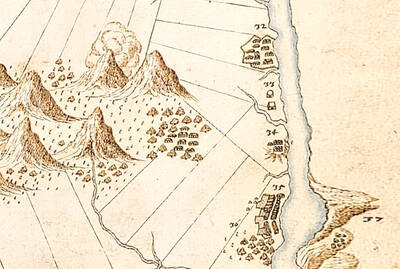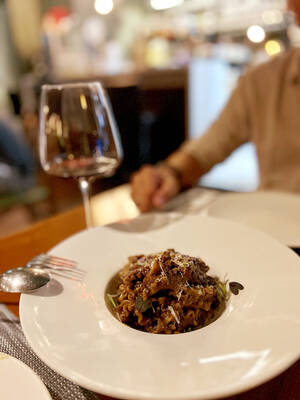This book follows in the wake of Gavin Menzies' 1421 [reviewed in Taipei Times Jan. 19, 2003]. Whereas Menzies, together with many other claims, speculated that a Chinese fleet reached North America in that year, Paul Chiasson points to an actual Canadian site that, he believes, contains the remains of a Chinese settlement.
Chiasson has much in common with Menzies. Both come to their sensational subject-matter via personal enthusiasm triggered by a chance incident, in Chiasson's case taking a hike up a small mountain. Neither is a professional historian — Menzies is a retired sea-captain and Chiasson a Toronto architect — and both books are marked by personal anecdote and descriptions of the circumstances in which they came across the documents, maps and sites they are now promoting.
The place Chiasson makes his claims for is a rocky hill called Cape Dauphin at the northern tip of Cape Breton Island in Canada's far southeast, not far from the border with the US. Clambering up its wooded slopes in the summer of 2001, he discovered a broad avenue of shaped rocks, now heavily overgrown but quite clearly, in his eyes, part of a human settlement. Historical enquiries led him to conclude that this was the legendary Island of Seven Cities, much discussed in Europe in the days of Columbus and his successor John Cabot (Giovanni Caboto) but never definitively located. A thin line of circumstantial evidence subsequently led Chiasson to believe that the inhabitants of this apparent settlement had been Chinese.
Menzies himself features prominently in The Island of Seven Cities. He's credited with reading the manuscript and offering useful suggestions and criticisms. Chiasson first met him in 2005 and subsequently gave a paper at a conference in Washington DC on his findings, and the book closes with the two men struggling up to the Cape Breton site together. Chiasson shows him what he takes to be some burial mounds, and Menzies says softly "Ming Dynasty graves. I believe I have just seen Ming Dynasty graves, untouched, forgotten. Amazing."
Chiasson is quite open about the disdain Gavin Menzies has attracted from some professional historians, as well as about the attraction the British writer feels to hyperbole. "He often described his revelations as being the best, the biggest and the greatest even before they had been thoroughly studied and understood," he writes. Chiassson's own tone is more muted, even though the two men's informal narrative approach has something in common.
There's another dimension to this book, however. Early on the author imparts the information that at the start of his researches he was diagnosed HIV-positive, and this, plus an early refusal to accept any further medication, then the arrival of new drugs, mark various points in the story. Quite why this material is included is unclear. One result, though, is that it helps emphasize that this is very much a personal account rather than a piece of professional history. This aspect is underlined by descriptions of family meals (trips to Cape Breton were initially vacation interludes in Chiasson's professional life), doubts about his own competence, and then bursts of renewed enthusiasm.
You only have to look up this book on Google to find a mass of derisory comment. One blogger, Rob Ferguson, claims that the aerial photo of Cape Dauphin showing some kind of road, that Chiasson dates 1929, was actually taken in 1953 and exhibits firebreaks. Other photos, the same writer insists, show roads developed in connection with a proposed quarry site, plans for which were later abandoned.
More evidence is presented in this book than it's possible to detail here. Prominent are arguments about the conceivable influence of Chinese on the Native American Mi'kmaq language, and about characteristic Chinese building techniques and habits that make, in the author's eyes, the remains at Cape Dauphin unlike anything that might have been constructed by Vikings, Portuguese, and so on.
What is hard to understand is why, if there are what look like grave mounds on Cape Dauphin, they haven't been excavated, and any human remains subjected to mitochondrial DNA analysis. Results of this kind of scientific investigation would then take over from mud-slinging on the Internet, such as the accusation that Library and Archives Canada, in cataloguing this book as history rather than fiction, is merely advancing "a publisher's plans to deceive the public" (maritimeasia.ws/topic/1421bunkum.html).
Even so, the more you look at the widespread rejection of Menzies' thesis by professional historians, the more you come to wonder about the general approach of Chiasson's contribution to the phenomenon. It it's not only his inclusion of the HIV material — it's also his frequent citing of his Acadian (French American) ancestry. Of course, this may just be local color, something intended to give added vibrancy to a chatty yarn aimed at the general reader. But it could also be perceived as a kind of special pleading. Surely such an authentic Cape Breton resident, and someone whose life is at risk into the bargain, couldn't be guilty of simply adding fuel to the flames of what may in essence be simply a piece of under-researched populist myth-making?
In the final analysis you can't be sure. The Internet abounds with people with axes to grind, and this book itself describes activists at the Washington symposium who were out to discredit the entire Chinese-in-America hypothesis. All in all, though, the general state of research, and the limited scope of this new contribution to it, make it best to conclude that the arrival of Chinese mariners on the North American coast before that of the Europeans remains a conceivable, though so far decidedly unproven, scenario.

Last week gave us the droll little comedy of People’s Republic of China’s (PRC) consul general in Osaka posting a threat on X in response to Japanese Prime Minister Sanae Takaichi saying to the Diet that a Chinese attack on Taiwan may be an “existential threat” to Japan. That would allow Japanese Self Defence Forces to respond militarily. The PRC representative then said that if a “filthy neck sticks itself in uninvited, we will cut it off without a moment’s hesitation. Are you prepared for that?” This was widely, and probably deliberately, construed as a threat to behead Takaichi, though it

Nov. 17 to Nov. 23 When Kanori Ino surveyed Taipei’s Indigenous settlements in 1896, he found a culture that was fading. Although there was still a “clear line of distinction” between the Ketagalan people and the neighboring Han settlers that had been arriving over the previous 200 years, the former had largely adopted the customs and language of the latter. “Fortunately, some elders still remember their past customs and language. But if we do not hurry and record them now, future researchers will have nothing left but to weep amid the ruins of Indigenous settlements,” he wrote in the Journal of

Even after years in business, weekend tables here can be booked out a month in advance. The price point far exceeds its competitors. Granted, expectations are soaringly high, but something here failed to hit the high notes. There are a few telltale signs that a restaurant relies solely on outstanding food to create the experience, no gimmicks or distractions needed. La Mole is such a restaurant. The atmosphere is food-forward, with an open kitchen center stage. Our tables are simple; no candles, no dim lighting, no ambient music. The menu is brief, and our waiter directs most

Seven hundred job applications. One interview. Marco Mascaro arrived in Taiwan last year with a PhD in engineering physics and years of experience at a European research center. He thought his Gold Card would guarantee him a foothold in Taiwan’s job market. “It’s marketed as if Taiwan really needs you,” the 33-year-old Italian says. “The reality is that companies here don’t really need us.” The Employment Gold Card was designed to fix Taiwan’s labor shortage by offering foreign professionals a combined resident visa and open work permit valid for three years. But for many, like Mascaro, the welcome mat ends at the door. A